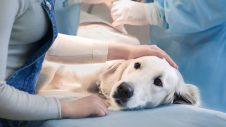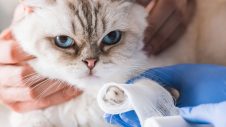Why have your cat desexed (spayed)?
Unwanted kittens can be an emotional and financial burden. They as well add to the already enormous problem of stray animals. Every year, thousands of unwanted pets are euthanised in shelters across Australia. Stray cats also present a public health risk from diseases spread by animal droppings. Medical services treat hundreds of bite cases every year, many caused by strays. It is every pet owner’s responsibility to ensure their pet does not add to these problems.
What if I keep my cat at home?
Queens ‘on heat’ attract a surprising number of interested members of the opposite sex, commonly leading to pregnancy, catfights, disturbed nights for owners, and irate neighbours.
The risk of uterine infections in cats that aren’t desexed is high and increases with age. These infections are often serious and potentially fatal. Mammary tumour incidence later in life is much lower in cats desexed before puberty.
When is it best to have your cat spayed?
Generally, it is considered best done before puberty (approximately six months of age), although the operation can be done at a later age.
How do I get my cat desexed?
For elective (non-urgent) surgery, please book in advance (one to two days notice is preferred). Your cat should be fasted prior to surgery. Give a light meal and remove all food and water overnight. Allow no food or water on the day of surgery.
The operation
Desexing involves intra-abdominal surgery performed under a general anaesthetic and sterile conditions in the operating theatre. An outline of the procedure follows:
Anaesthesia
A general anaesthetic is given by intravenous injection. Surgical staff monitor the depth of anaesthesia at all times during the operation.
Premedication – is a sedative injection to relieve anxiety and relax the patient for anaesthesia
Anaesthetic – is administered by intravenous injection and maintenance of anaesthesia by inhalation of anaesthetic gases
Preparation
Skin preparation – clip and three-stage scrub of skin to produce a sterile site for surgery.
Surgery
1. site draped with sterile linen drapes
2. incisions through the skin, subcutaneous tissue, abdominal wall and lining
3. location and cutting of left and right ovarian ligaments
4. clamping and ligation (tying off) of ovarian arteries and veins
5. the body of the uterus clamped and ligated along with the uterine arteries and veins just in
front of the cervix. Both the ovaries and the entire uterus are then removed
6. the abdominal wall muscles and subcutaneous tissue sutured closed
7. all internal sutures are of an absorbable material so that they slowly ‘dissolve’ over the weeks following surgery once healing has occurred
8. skin incision sutured together with a non-absorbable suture material.
Recovery
All patients are carefully observed until they wake from the anaesthetic. They are then allowed to quietly ‘sleep off’ the after effects of the anaesthetic. Time taken to do this varies considerably between patients. Patients are discharged when it is safe for them to leave the hospital.
After Care at home
Strict confinement is recommended on going home. Running, jumping, and vigorous exercise is not advised.
Please check the wound daily for discharges, swelling or missing sutures. Please do not bath your cat until the sutures have been removed.
A brief visit to the surgery during consulting hours is required to have the sutures removed. There’s no charge for this visit. Suture removal is usually done 10 days after the operation, but the veterinarian may specify otherwise at the time of discharge.
How much does desexing cost?
The basic fee set (usually quoted by telephone enquiries) is dependent on your cat’s age and condition. Prices may increase if the patient is ‘on heat’, overweight, exceptionally large or has borne several litters. Please ask the vet for an estimate of fees on admission.
Fees are kept as low as possible to encourage desexing of pets. Consultation and theatre fees are usually not charged for desexing, and hospitalisation is provided free.
To book your cat in for desexing, contact your local Greencross Vets, or use our online booking form.

 Greencross Vets
Greencross Vets 






